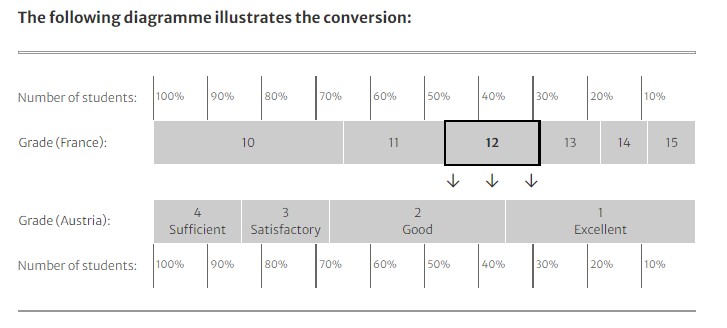
Apply to a foreign university with confidence
- Properly fulfilled documents
- Perfect motivation letter
- Support from a personal mentor
- Offers from several universities
Article score: 4 out of 5 (1 review)
What is ECTS? We tell you how credits are taken into account during transfer and admission, and how universities grade students according to the credits.
Free consultation




ECTS (or the European Credit Transfer and Accumulation System) is the European system for credit transfer and accumulation. Each seminar and course are evaluated using ECTS points — credits. Credits are calculated based on the number of hours the student has spent studying the subject. One credit is equal to about 25-30 hours.
We explain why credits are needed, as well as how they are awarded and taken into account when applying for master's and PhD programs.
The ECTS credit system is used in 48 member countries of the European Higher Education Area (EHEA) that have adopted the Bologna system. This agreement includes countries from the EU, Turkey, Asia, and the CIS, including Belarus, Kazakhstan, and others.
The ECTS system serves various purposes, primarily:
The typical academic year spans 36-40 weeks, which corresponds to approximately 1500-1800 hours of study per year. On average, students are expected to earn 60 ECTS credits per year. As a result, a three-year bachelor's degree program consists of 180 credits, a four-year program totals 240 credits, and a two-year master's degree program requires 120 credits.
One ECTS credit represents about 25-30 hours. However, this estimate can vary from country to country. For example, in Austria, one credit is considered equivalent to 25 hours, while in France, it is approximately 29 hours[1].
These hours include not only classroom lectures, but also practical activities, diploma or thesis work, and individual time spent on homework and assignments.
Grades do not impact the number of credits earned. Regardless of the actual grade received, the allocated number of credits remains the same for all students who successfully pass the exam.
Grading scales vary across most EU countries. For instance, the Czech Republic follows a five-point system, while France adopts a twenty-point system. This diversity in grading scales poses challenges when transferring credits or enrolling in a different university, since there is currently no official system for direct conversion.
To address this issue, the ECTS Commission has developed its own grading scheme. Universities incorporate this scheme as a supplementary tool alongside their official grading systems. Admissions offices in different countries can use it to compare an applicant's grades with their university's grading system. It serves as an internal reference, eliminating the need for manual calculations and ensuring a standardized approach to grade comparison.
Prior to 2009, grades were equated with percentage completion. For instance, an "A" grade was awarded to students who completed at least 90% of the course, "B" to those who achieved 80%, and so on. The grading table included seven ratings: A, B, C, D, E, Fx, and F.
Since 2009, universities have implemented a new grading system. Although it may seem more complicated, the creators consider it to be more transparent and objective.
Under the new regulations, the ECTS commission suggests that each university constructs its own grade conversion table. Universities convert grades based on percentiles, considering the percentage of students who score below a certain level in an exam.
The ECTS Commission believes that assessing based on the passing student threshold is more objective than relying on an approximate completion percentage.
During the admission process or when transferring from one university to another, admissions committees can evaluate the grades of a student by referring to their transcript and the grade conversion table adopted by the university.

For admission to master's programs, it is important to assess if the number of ECTS credits earned during your bachelor's studies meets the requirements of the specific university. Criteria for each field of study are typically provided on the university's website, where a minimum of 180 credits is often required for admission.
In some cases, universities may have preferences regarding the number of credits in a particular subject area. For example, when applying for finance, universities may expect a minimum of three credits in higher mathematics, indicating that you have acquired at least 75-90 hours of core subject knowledge. This system enables an accurate assessment of a student's proficiency in a more specialized or closely related bachelor's field.
If you studied in a country where one credit is equivalent to 25 hours, and you are applying to a country where 30 hours are considered as one credit, you will need to recalculate the number of credits stated on your diploma.
Due to variations in academic systems, the ECTS credits alone may not be enough. In such cases, applicants can make up for the missing credits through elective courses or by studying abroad on an exchange program during their bachelor's degree. After graduation, additional specialized courses can be taken. Always verify the number of credits you will receive upon program completion, confirm if the institution is authorized to grant credits to applicants, and understand how the subject will be recorded on your diploma or certificate. Such programs usually involve tuition fees.
PhD programs themselves do not use ECTS credits. Instead, they require a certain number of points for admission. Typically, a minimum of 240 credits is needed, which corresponds to three years of bachelor’s studies and one year of master's studies. Please refer to official university websites for specific requirements.
When applying for a PhD program, similar to a master's program, the number of credits in a specialized subject area may be taken into consideration.
In the United States, the USCS credit system is based on classroom hours. A credit unit is usually equivalent to 50 minutes of instruction. When presenting an ECTS diploma for admission in the US, the credits are divided in half. For example, 60 ECTS credits are equal to 30 US credits.
Countries of the Asia-Pacific region have their own credit system known as UCTS (University Credit Transfer System). It includes countries participating in the UMAP University Mobility Program, such as Australia, Canada, Korea, China, Singapore, and others. UCTS credits facilitate educational exchange among UMAP partner countries. The academic year in UCTS is equivalent to 60 credits, similar to the ECTS system.
60+ countries
we work with
$1,000,000 saved
by students through scholarships
6,400 offers
our students got